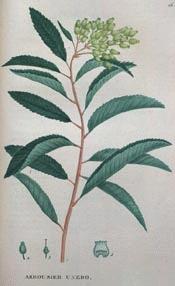
Botanical.com Home Page

|
Strawberry Tree
(Arbutus unedo)
Click on graphic for larger image
|
Arbutus (Strawberry Tree)
Botanical: Arbutus unede
Family: N.O. Ericaceae
---Habitat---In the woods at Killarney and Bantry is found growing wild the beautiful evergreen shrub, known as the Arbutus, or Strawberry Tree (Arbutus unede), which for its attractiveness should gain a place in every well-planted garden. It would, indeed, be hard to find any other ornamental shrub or tree that has such a cheerful appearance throughout the autumn and early winter, when its dense mass of greenery is mingled with a profusion of flower clusters and ruddy, round fruit resembling small strawberries. The creamy-white, bell-shaped flowers, often tinged with pink, are intermixed with the orange-scarlet rough fruit, which owing to the length of time it takes to ripen, remains on the tree for twelve months, not maturing until the autumn succeeding that in which the flower is produced.
Although a native of South Europe, and only growing wild here in the South of Ireland on the rocks at Killarney, the Arbutus will thrive almost anywhere in this country, especially in warm and coast regions, where it will grow 20 feet high, making huge, globular masses of green, though ordinarily its height is only from 8 to 10 feet. In inland districts it is liable to be cut down during exceptionally severe winters, but this rarely happens, and if large bushes are apparently killed by cold, they almost invariably send up strong shoots again. When young, it requires in order to get it established, a slight protection during winter. It grows quickly in sheltered places but dislikes shade, and seems to be most at home in a deep, light soil, flourishing best in a sandy loam.
When eaten in quantities this fruit is said to be narcotic, and the wine made from it in Spain has the same property.
The tree is common in the Mediterranean region, and the fruit was known to the ancients, but according to Pliny (who gave the tree the name of Arbutus) was not held in much esteem, as the name implies (un ede=one 1 eat), the fruits being considered so unpalatable, that no one tasting them for the first time would be tempted to repeat the experiment. Nevertheless, there is some evidence that at one time the fruit was an article of diet with the ancients. Horace praises the tree for its shade and Ovid for its loads of 'blushing fruit.' Virgil recommends the young shoots as winter food for goats and for basket-work.
Gerard speaks of it in his time as growing in 'some few gardens,' and says, 'the fruit being ripe is of a gallant red colour, in taste somewhat harsh, and in a manner without any relish, of which thrushes and blackbirds do feed in winter .'
In Spain, a sugar and spirit have been extracted from the fruit and a wine made from it in Corsica.
In the neighbourhood of Algiers it forms hedges, and in Greece and Spain the bark has been used for tanning. The wood of the tree makes good charcoal.
[Top]
Common Name Index
A MODERN HERBAL Home Page
Bear in mind "A Modern Herbal" was written with the conventional wisdom of the early 1900's. This should be taken into account as some of the information may now be considered inaccurate, or not in accordance with modern medicine.
© Copyright Protected 1995-2025 Botanical.com
|

